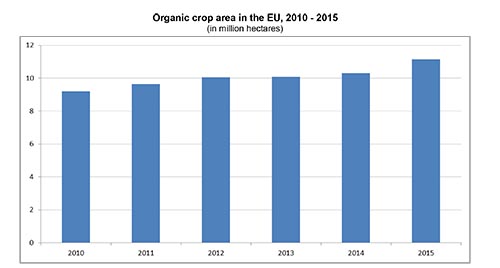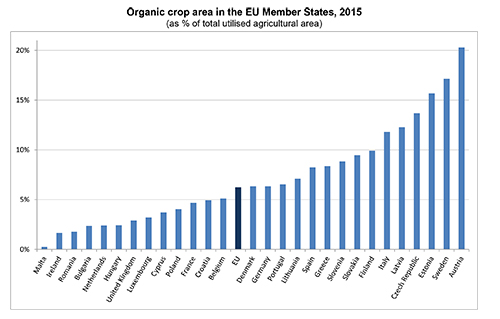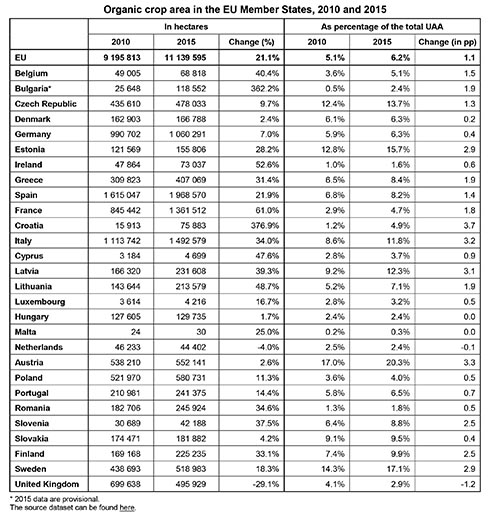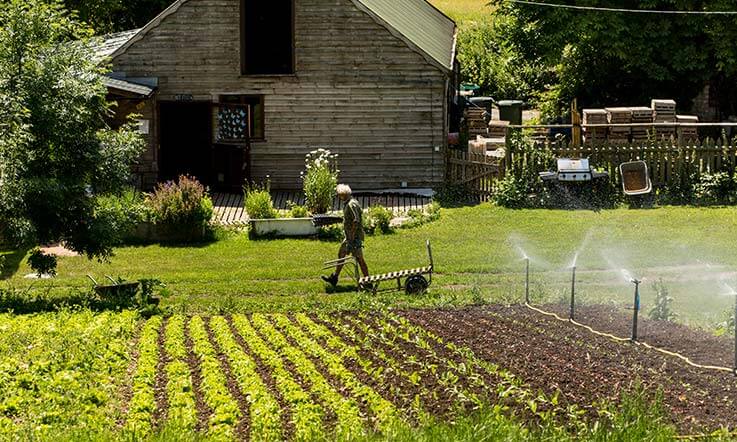


With more than 11 million hectares of certified area or area under conversion in 2015, organic farming made up 6.2% of the European Union’s (EU) total utilised agricultural area (UAA). Since 2010, the area devoted to organic farming has grown by almost two million hectares. Similarly, an upward trend can be observed for the number of registered organic producers. At the end of 2015, 271 500 organic agricultural producers were registered in the EU, an increase of 5.4% compared with 2014.
Among Member States, Spain, Italy, France and Germany registered the largest organic areas as well as the largest numbers of organic producers in 2015, accounting together for over half (52%) of both total EU organic crop area and organic producers in the EU.
This information comes from an article issued by Eurostat, the statistical office of the European Union, and shows only a small selection of the wide range of data on organic farming available at Eurostat. Organic farming combines best environmental practices, a high level of biodiversity, the preservation of natural resources and high production standards based on natural substances and processes. It provides for a specific market responding to a specific consumer demand while at the same time delivering public goods in terms of environmental protection, animal welfare and rural development.
The proportion of agricultural land farmed organically differs widely between EU Member States. The highest share of crop area dedicated to organic farming was registered in Austria, with one fifth (20%, or 552 thousand hectares) of its total agricultural area farmed organically in 2015. It was followed by Sweden (17%, or 519 thousand hectares) and Estonia (16%, or 156 thousand hectares). Alongside these top performers, the Czech Republic (14%, or 478 thousand hectares), Italy (12%, or 1 493 thousand hectares) and Latvia (12%, or 232 thousand hectares) also reported over 10% of agricultural land farmed organically.
In contrast, organic farming was not strongly developed in three Member States with the area under organic farming below 2% of agricultural land: in Malta (0.3%, or 30 hectares), Ireland (1.6%, or 73 thousand hectares) and Romania (1.8%, or 246 thousand hectares).
It should be noted that the importance of the organic sector is generally lower in regions with plains where more intensive production systems prevail.
At EU level, the area dedicated to production of organic crops in 2015 has increased by 21% since 2010 to slightly more than 11 million hectares, with the landmark of 10 million hectares having been reached in 2012. Organic land area has risen over this period in all Member States, except the United Kingdom (-29%) and, to a lesser extent, the Netherlands (-4%). In contrast, Croatia (from 16 thousand hectares of organic land in 2010 to almost 76 thousand hectares in 2015, or +377%) and Bulgaria (+362%) recorded an almost fourfold increase of their land devoted to organic farming. They were followed at a distance by France (+61%), Ireland (+53%), Lithuania (+49%) and Cyprus (+48%).
